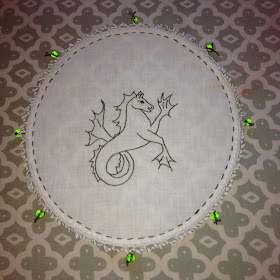The original, vintage doily
I marked my heraldic design out by tracing it onto the linen doily with a removable pen, using a window as a light box.
When the main embroidery was done, I did a line of running stitch around the edge of the doily and also wove some floss around the needle lace edging.
Some beads were required to finish it off and add weight to the cover. I used some green glass beads and secured them with the embroidery floss.
My cover is very simple, but suits my needs. I had just finished pressing it when the crucial vet call came in, so the timing was good. Quick projects can sometimes be just what I need to get my motivation and enthusiasm for craftwork back.
Here are some SCA-period chalice covers (used in a religious context) in case you feel inspired to make something more complex:
 |
| Image from V&A Museum: http://collections.vam.ac.uk/item/O125784/chalice-veil-unknown/ |
Date: ca. 1560 to ca. 1600 (made)
Materials and Techniques: linen, silk embroidery
Museum number: 1415-1874
Gallery location: In Storage
 |
| Image from: LACMA https://collections.lacma.org/node/224478 |
Costumes; ensembles
Linen plain weave with silk embroidery, metallic-wrapped thread lace
22 1/2 × 22 3/4 in. (57.15 × 57.79 cm)
''Shepheard Buss'' Textile held in the V&A, Image from https://www.pinterest.com.au/malcm2557/shepheard-buss/
Place of origin: England (made)
Date: 1570-1600 (made)
Materials and Techniques: Embroidered linen in silk, bobbin lace
Museum number: T.219-1953
Gallery location: British Galleries, Room 58, case 6
http://collections.vam.ac.uk/item/O78790/shepheard-buss-picture-unknown/
 |
| Russian Chalice Veil. Image from Pinterest https://www.pinterest.se/pin/386887424219161266/ |
Attribution not confirmed.






